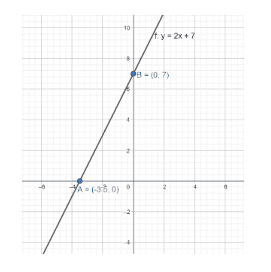
How do you graph the function of $y=2x+7$?
Answer
540k+ views
Hint: In this problem they have asked to draw the graph of the given equation. There are several methods to draw the graph of the linear equation. We can observe that the given equation is a linear equation and it will be a straight line when we draw its graph. To draw a straight line, we need a minimum of two points that lie or satisfy the given equation. In this problem, we will use the intercepts of the given equation to draw a straight line. We know that the intercepts are the points where the line meets the $x-axis$, $y-axis$. We know that the equation of the $x-axis$ is $y=0$. So, we will substitute $y=0$ in the given equation to calculate the point where the line meets the $x-axis$. We know that the equation of the $y-axis$ is $x=0$, so we will substitute $x=0$ in the given equation to calculate the point where the given line meets the $y-axis$. Now we will denote these points on a graph paper and join them together to get the required graph.
Complete Step by Step Solution:
Given line, $y=2x+7$
Finding the point where the line meets the $x-axis$ by substituting $y=0$ in the above equation, then we will get
$\begin{align}
& 0=2x+7 \\
& \Rightarrow 2x=-7 \\
\end{align}$
Dividing the above equation with $2$ on both sides, then we will get
$\begin{align}
& \Rightarrow \dfrac{2x}{2}=\dfrac{-7}{2} \\
& \Rightarrow x=-\dfrac{7}{2} \\
\end{align}$
Hence the line $y=2x+7$ meets the $x-axis$ at point $\left( -\dfrac{7}{2},0 \right)$.
Finding the point where the line meets the $y-axis$ by substituting $x=0$ in the above equation, then we will get
$\begin{align}
& y=2\left( 0 \right)+7 \\
& \Rightarrow y=7 \\
\end{align}$
Hence the line $y=2x+7$ meets the $y-axis$ at point $\left( 0,7 \right)$.
Now plotting the points $\left( -\dfrac{7}{2},0 \right)$, $\left( 0,7 \right)$ on a graph paper and joining them to get the graph of the given line. Then the graph is looks like below

Note:
In this above solution, we have calculated the intercepts of the given line and joined them to get the required line. We can also calculate any point on the line by assuming either $x$ or $y$ value and calculating the remaining variable value from the given equation and writing it as a point. After calculating all the points, we can join them to get the required line.
Complete Step by Step Solution:
Given line, $y=2x+7$
Finding the point where the line meets the $x-axis$ by substituting $y=0$ in the above equation, then we will get
$\begin{align}
& 0=2x+7 \\
& \Rightarrow 2x=-7 \\
\end{align}$
Dividing the above equation with $2$ on both sides, then we will get
$\begin{align}
& \Rightarrow \dfrac{2x}{2}=\dfrac{-7}{2} \\
& \Rightarrow x=-\dfrac{7}{2} \\
\end{align}$
Hence the line $y=2x+7$ meets the $x-axis$ at point $\left( -\dfrac{7}{2},0 \right)$.
Finding the point where the line meets the $y-axis$ by substituting $x=0$ in the above equation, then we will get
$\begin{align}
& y=2\left( 0 \right)+7 \\
& \Rightarrow y=7 \\
\end{align}$
Hence the line $y=2x+7$ meets the $y-axis$ at point $\left( 0,7 \right)$.
Now plotting the points $\left( -\dfrac{7}{2},0 \right)$, $\left( 0,7 \right)$ on a graph paper and joining them to get the graph of the given line. Then the graph is looks like below

Note:
In this above solution, we have calculated the intercepts of the given line and joined them to get the required line. We can also calculate any point on the line by assuming either $x$ or $y$ value and calculating the remaining variable value from the given equation and writing it as a point. After calculating all the points, we can join them to get the required line.
Recently Updated Pages
Master Class 12 Business Studies: Engaging Questions & Answers for Success

Master Class 12 Economics: Engaging Questions & Answers for Success

Master Class 12 English: Engaging Questions & Answers for Success

Master Class 12 Maths: Engaging Questions & Answers for Success

Master Class 12 Social Science: Engaging Questions & Answers for Success

Master Class 12 Chemistry: Engaging Questions & Answers for Success

Trending doubts
What is meant by exothermic and endothermic reactions class 11 chemistry CBSE

Which animal has three hearts class 11 biology CBSE

10 examples of friction in our daily life

One Metric ton is equal to kg A 10000 B 1000 C 100 class 11 physics CBSE

1 Quintal is equal to a 110 kg b 10 kg c 100kg d 1000 class 11 physics CBSE

Difference Between Prokaryotic Cells and Eukaryotic Cells




